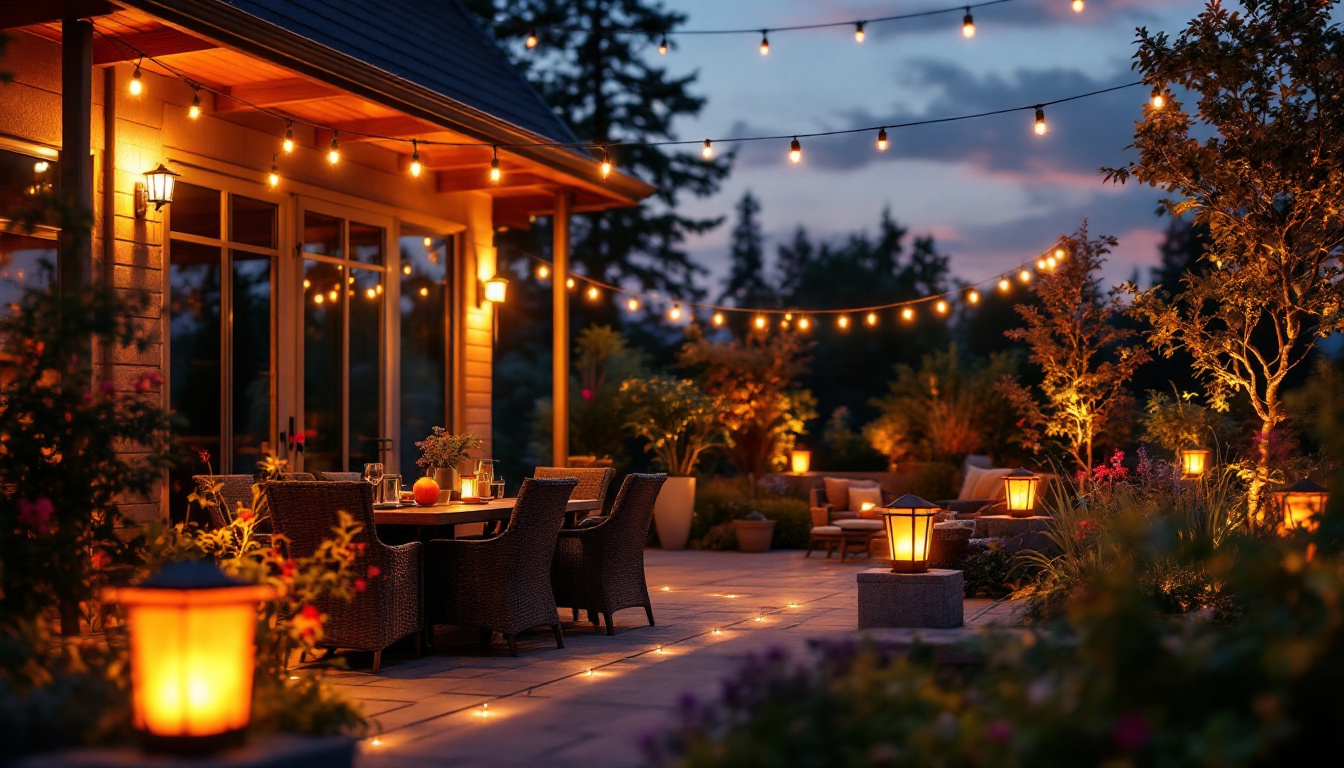
As the demand for sustainable and energy-efficient solutions continues to rise, solar lighting has emerged as a popular choice for outdoor spaces, particularly patios. For lighting contractors, understanding the nuances of solar lights can significantly enhance project offerings and client satisfaction. This article delves into proven methods for effectively utilizing solar lights in patio designs, ensuring that contractors can deliver optimal results.
Solar lights operate on a simple yet effective principle: they harness energy from the sun to power LED fixtures. This technology has advanced tremendously, making solar lights not only more efficient but also more reliable for outdoor use. With the increasing emphasis on sustainable energy solutions, solar lighting has gained popularity among homeowners and businesses alike, providing an eco-friendly alternative to traditional lighting systems.
Moreover, the integration of smart technology into solar lighting systems has further enhanced their functionality. Many modern solar lights now come equipped with motion sensors, timers, and even remote control capabilities, allowing users to customize their lighting experience. This innovation not only improves energy efficiency but also adds an extra layer of security to outdoor spaces, as lights can automatically illuminate when motion is detected.
A typical solar lighting system consists of several key components: solar panels, batteries, LED lights, and a controller. The solar panels collect sunlight during the day, converting it into electricity. This energy is stored in batteries for use at night, powering the LED lights.
Understanding each component’s role is crucial for contractors. For instance, the quality of the solar panel directly impacts the efficiency of energy conversion, while the battery capacity determines how long the lights will operate after sunset. Choosing high-quality components can enhance the overall performance and longevity of the solar lighting system. Additionally, the controller plays a vital role in managing the flow of energy between the solar panels, batteries, and lights, ensuring optimal performance and preventing overcharging or discharging of the batteries.
Furthermore, advancements in battery technology, such as lithium-ion batteries, have significantly improved the reliability and lifespan of solar lighting systems. These batteries can hold more energy and charge faster than traditional lead-acid batteries, making them a preferred choice for modern solar installations.
There are various types of solar lights suitable for patios, each offering unique benefits. Path lights, for instance, are ideal for illuminating walkways and garden borders, enhancing safety and aesthetics. String lights can create a cozy atmosphere, perfect for social gatherings. Additionally, spotlights can be used to highlight specific features, such as trees or architectural elements.
Contractors should consider the specific needs of each project when selecting solar light types. Factors such as the layout of the patio, the desired ambiance, and the existing landscape will influence the choice of fixtures. For example, in a large outdoor area, using a combination of different types of solar lights can create a layered lighting effect, providing both functional illumination and visual interest.
Moreover, decorative solar lights, such as lanterns or artistic sculptures, can serve as both lighting solutions and design elements, adding character to outdoor spaces. These options allow homeowners to express their personal style while benefiting from the practicality of solar energy. As the market continues to evolve, innovative designs and features are emerging, making solar lighting an increasingly versatile choice for outdoor environments.
Proper planning and design are essential for maximizing the effectiveness of solar lighting in patios. Lighting contractors must assess various factors to create a functional and visually appealing outdoor space.
A thorough site assessment is the first step in any lighting project. This involves evaluating the amount of sunlight the area receives throughout the day. Areas with ample sunlight are ideal for solar lights, while shaded spots may require alternative solutions or additional planning.
Contractors should also consider the layout of the patio and surrounding landscape. Identifying key focal points, such as seating areas or decorative features, will help in determining where to place the lights for maximum impact.
Incorporating basic lighting design principles can greatly enhance the effectiveness of solar lights. Layering light is a key concept, which involves using different types of lighting to create depth and interest. For instance, combining ambient lighting with task and accent lighting can transform a patio into a versatile space suitable for various activities.
Moreover, the color temperature of the lights can influence the overall mood. Warmer tones create an inviting atmosphere, while cooler tones may be more suitable for modern designs. Understanding these principles will allow contractors to tailor their designs to meet client preferences.
Once the planning and design stages are complete, the next step is installation. Proper installation is critical for ensuring the longevity and effectiveness of solar lights. Following best practices can help contractors avoid common pitfalls.
Placement is key to maximizing the functionality of solar lights. Ideally, fixtures should be positioned where they can receive direct sunlight for most of the day. This ensures that the batteries are fully charged, allowing the lights to operate effectively at night.
Additionally, lights should be placed at appropriate heights to provide adequate illumination without causing glare. For path lights, a height of 18 to 24 inches is typically recommended, while accent lights may be positioned higher to create dramatic effects.
Securing solar fixtures is essential to prevent damage from wind or accidental bumps. Many solar lights come with stakes or mounts that can be anchored into the ground or attached to surfaces. Contractors should ensure that these fixtures are installed securely to withstand various weather conditions.
Maintenance is another important aspect of solar lighting. Regularly cleaning the solar panels and checking the batteries can prolong the life of the fixtures. Contractors should advise clients on simple maintenance tasks to keep their solar lights functioning optimally.
To ensure that solar lights perform at their best, contractors can implement several strategies. These methods can enhance the efficiency and effectiveness of solar lighting systems, ultimately leading to greater client satisfaction.
Integrating smart technology into solar lighting systems can provide added convenience and control. Smart solar lights can be programmed to turn on and off at specific times, or they can be controlled remotely via smartphone apps. This feature not only enhances user experience but also optimizes energy consumption.
Contractors should stay informed about the latest advancements in smart solar technology. Offering clients these cutting-edge solutions can set a contractor apart from competitors and demonstrate a commitment to innovation.
In some cases, combining solar lights with traditional lighting can provide the best of both worlds. For example, using solar lights in areas with ample sunlight while supplementing with traditional fixtures in shaded areas can create a comprehensive lighting solution. This hybrid approach can ensure that the patio remains well-lit throughout the night.
Contractors should assess the specific needs of each project to determine the most effective combination of lighting sources. This flexibility can enhance the overall functionality and aesthetics of the patio space.
Examining successful case studies can provide valuable insights into effective solar lighting applications. These examples illustrate how lighting contractors have successfully implemented solar solutions in various patio settings.
In a recent residential project, a contractor was tasked with transforming a dull backyard patio into an inviting outdoor living space. By strategically placing solar path lights along the walkways and installing solar string lights overhead, the contractor created a warm and welcoming atmosphere.
The client reported a significant increase in outdoor usage, with family gatherings and evening dinners becoming more frequent. This project highlights the potential of solar lighting to enhance the functionality and enjoyment of outdoor spaces.
Another successful project involved a commercial establishment looking to enhance its outdoor dining area. The contractor opted for solar spotlights to highlight the restaurant’s architectural features and solar lanterns on each table for ambient lighting.
The result was a beautifully lit space that attracted more customers during the evening hours. The establishment not only reduced its energy costs but also created a unique dining experience that set it apart from competitors.
The solar lighting industry is constantly evolving, with new trends emerging that can impact the way contractors approach their projects. Staying informed about these trends is essential for lighting contractors aiming to remain competitive.
Recent advancements in solar technology have led to more efficient solar panels and longer-lasting batteries. These improvements mean that solar lights can now operate effectively even in less-than-ideal conditions. Contractors should keep an eye on these developments to ensure they are offering the best products to their clients.
As sustainability becomes a more pressing concern, the demand for eco-friendly solutions like solar lighting is expected to grow. Contractors who prioritize sustainable practices in their projects will likely find a receptive market. This includes not only using solar lights but also promoting environmentally friendly installation methods and materials.
Solar lighting presents a wealth of opportunities for lighting contractors looking to enhance their service offerings. By understanding the technology, planning effectively, and implementing best practices, contractors can create stunning and functional outdoor spaces that meet the needs of their clients.
As the industry continues to evolve, staying informed about advancements and trends will be crucial for success. Embracing solar lighting not only benefits contractors but also contributes to a more sustainable future.
Ready to elevate your patio lighting projects with the best solar solutions on the market? Look no further than LumenWholesale, where we provide lighting contractors with high-quality, specification-grade lighting products at unbeatable wholesale prices. Our extensive selection is designed to meet the highest industry standards, ensuring you deliver reliable and high-performance lighting to your clients. Plus, with free shipping on bulk orders, you can enjoy premium lighting at the best value — without hidden fees or compromises. Don’t miss out on the perfect blend of quality, affordability, and convenience. Explore our wholesale lighting options and make your next project shine!

Discover the essentials of garage lighting with insights tailored for contractors.

Discover the essential insights lighting contractors need to know about LED undercounter lights.

Discover how lighting contractors can harness the power of UV light disinfection to enhance safety and efficiency in various settings.

Discover the answers to lighting contractors’ most frequently asked questions during a chandelier sale.